Optimizing the Auxiliary Air Channels of a Vortex Atomizer by 3D Printing Using the Taguchi Method
Abstract
1. Introduction
2. Fabrication of Auxiliary Air Channels of the Vortex Atomizer by 3D Printing
3. Experimental Approach
4. Results and Discussion
4.1. Spraying Patterns
4.2. Analysis of Signal to Noise Ratios and Quality Characteristic
4.3. Validation
4.4. CFD Simulation Validation
5. Conclusions
Author Contributions
Funding
Institutional Review Board Statement
Informed Consent Statement
Conflicts of Interest
References
- Lefebvre, A.H.; McDonell, V.C. Atomization and Sprays, 2nd ed.; Taylor & Francis, CRC Press: Boca Raton, FL, USA, 2017. [Google Scholar]
- Liang, J.-L.; Zhang, F.; Zhang, J.-H.; Huang, H.-Q.; Wen, Y.-X.; Chen, B.-C. Improvement of Mesh Atomizer Performance by Electrolytic Polishing. Appl. Sci. 2023, 13, 2572. [Google Scholar] [CrossRef]
- Krawczyk, P.; Badyda, K. A design procedure for “liquid to air” type atomizers based on air and water mixture outflow velocity. Chem. Process Eng. 2015, 36, 355–363. [Google Scholar] [CrossRef]
- Ochowiak, M.; Krupinska, A.; Włodarczak, S.; Matuszak, M.; Markowska, M.; Janczarek, M.; Szulc, T. The Two-Phase Conical Swirl Atomizers: Spray Characteristics. Energies 2020, 13, 3416. [Google Scholar] [CrossRef]
- Yadav, N.P.; Kushari, A. Spray Formation in a Twin-Fluid Internally Mixed Atomizer with Tangential Air Intake. Part. Part. Syst. Charact. 2011, 28, 25–32. [Google Scholar] [CrossRef]
- Chinn, J.J.; Cooper, D.; Yule, A.J.; Nasr, G.G. Stationary rotary force waves on the liquid–air core interface of a swirl atomizer. Heat Mass Transf. 2015, 52, 2037–2050. [Google Scholar] [CrossRef]
- Wang, M.R.; Yang, K.H.; Chiu, C.H.; Yang, C.J. Mechanisms and characteristics of spray formation with flow focusing in a new air-assist micro-atomizer. Mod. Phys. Lett. 2009, 23, 365–368. [Google Scholar] [CrossRef]
- Wachter, S.; Jakobs, T.; Kolb, T. Mass Flow Scaling of Gas-Assisted Coaxial Atomizers. Appl. Sci. 2022, 12, 2123. [Google Scholar] [CrossRef]
- Maly, M.; Jedelsky, J.; Slama, J.; Janackova, L.; Sapik, M.; Wigley, G. Internal flow and air core dynamics in Simplex and Spill-return pressure-swirl atomizers. Int. J. Heat Mass Transf. 2018, 123, 805–814. [Google Scholar] [CrossRef]
- Zhao, H.; Liu, H.F.; Tian, X.S.; Xu, J.L.; Li, W.F.; Lin, K.F. Influence of atomizer exit area ratio on the breakup morphology of coaxial air and round water jets. AIChE J. 2014, 60, 2335–2345. [Google Scholar] [CrossRef]
- Levitsky, I.; Tavor, D. Improved Atomization via a Mechanical Atomizer with Optimal Geometric Parameters and an Air-Assisted Component. Micromachines 2020, 11, 584. [Google Scholar] [CrossRef]
- Baltrėnas, P.; Baltrėnaitė-Gedienė, E. Research of Modified Atomizers and Their Application for Moistening of Air-Cleaning Device Charges. Sustainability 2019, 11, 5522. [Google Scholar] [CrossRef]
- Li, W.; Qian, L.; Song, S.; Zhong, X. Numerical Study on the Influence of Shaping Air Holes on Atomization Performance in Pneumatic Atomizers. Coatings 2019, 9, 410. [Google Scholar] [CrossRef]
- Wittner, M.O.; Karbstein, H.P.; Gaukel, V. Air-Core-Liquid-Ring (ACLR) Atomization: Influences of Gas Pressure and Atomizer Scale Up on Atomization Efficiency. Processes 2019, 7, 139. [Google Scholar] [CrossRef]
- Marchewicz, A.; Sobczyk, A.T.; Krupa, A.; Jaworek, A. Induction charging of water spray produced by pressure atomizer. Int. J. Heat Mass Transf. 2019, 135, 631–648. [Google Scholar] [CrossRef]
- Belhadef, A.; Vallet, A.; Amielh, M.; Anselmet, F. Pressure-swirl atomization: Modeling and experimental approach-es. Int. J. Multiph. Flow 2012, 39, 13–20. [Google Scholar] [CrossRef]
- Zhang, H.; Bai, B.; Liu, L.; Sun, H.; Yan, J. Droplet dispersion characteristics of the hollow cone sprays in crossflow. Exp. Therm. Fluid Sci. 2013, 45, 25–33. [Google Scholar] [CrossRef]
- Tambe, S.B.; Jeng, S.M.; Mongia, H.; Hsiao, G. Liquid Jets in Subsonic Crossflow. In Proceedings of the 43rd AIAA Aerospace Sciences Meeting and Exhibit, Reno, Nevada, 10–13 January 2005; pp. 1–12. [Google Scholar]
- Sallam, K.; Ng, C.; Sankarakrishnan, R.; Aalburg, C.; Lee, K. Breakup of Turbulent and Non-Turbulent Liquid jets in Gaseous Crossflows. In Proceedings of the 44th AIAA Aerospace Sciences Meeting and Exhibit, Reno, Nevada, 9–12 January 2006; pp. 1–13. [Google Scholar]
- Costa, M.; Melo, M.J.; Sousa, J.M.M.; Levy, Y. Spray Characteristics of Angled Liquid Injection into Subsonic Crossflows. Am. Inst. Aeronaut. Astronaut. 2006, 44, 646–653. [Google Scholar] [CrossRef]
- Khosravani, M.R.; Reinicke, T. Effects of fiber on the fracture behavior of 3D-printed fiber reinforced nylon. Procedia Struct. Integr. 2022, 35, 59–65. [Google Scholar] [CrossRef]
- Aranda, M.T.; Reinoso, J.; García, I.G. On different 3D printing methods and fracture performance in DCB composite specimens including structured interfaces. Theor. Appl. Fract. Mech. 2022, 122, 103552. [Google Scholar] [CrossRef]
- Chacona, J.M.; Caminerob, M.A.; García-Plazab, E.; Núñezb, P.J. Additive manufacturing of PLA structures using fused deposition modelling: Effect of process parameters on mechanical properties and their optimal selection. Mater. Des. 2017, 124, 143–157. [Google Scholar] [CrossRef]
- Kanjirakat, A.; Carvero, A.; Amani, M.; Retnanto, A. Surface modification of stereolithography-based 3D printed structures utilizing ultrasonic-atomised sprays. J. Mater. Sci. 2023, 58, 6931–6943. [Google Scholar] [CrossRef]
- Gul, J.Z.; Sajid, M.; Rehman, M.M.; Siddiqui, G.U.; Shah, I.; Kim, K.-H.; Lee, J.-W.; Choi, K.H. 3D printing for soft robotics—A review. Sci. Technol. Adv. Mater. 2018, 19, 243–262. [Google Scholar] [CrossRef] [PubMed]
- Shah, I.; Jeon, H.S.; Ali, M.; Yang, D.H.; Choi, K.-H. Optimal parametric mixing analysis of active and passive micromixers using Taguchi method. Proc IMechE Part E J. Process Mech. Eng. 2019, 233, 1292–1303. [Google Scholar] [CrossRef]
- Hirt, C.W.; Nichols, B.D. Volume of Fluid (VOF) Method for the Dynamics of Free Boundaries. J. Comput. Phys. 1981, 39, 201–225. [Google Scholar] [CrossRef]
- Luo, S.; Wang, H.; Gao, Z.; Wu, Y.; Wang, H. Interaction between high-velocity gas and liquid in gas atomization revealed by a new coupled simulation model. Mater. Des. 2021, 212, 110264. [Google Scholar] [CrossRef]
- Lyras, P.; Hubert, A.; Lyras, K.G. A conservative level set method for liquid–gas flows with application in liquid jet atomization. Exp. Comput. Multiph. Flow 2023, 5, 67–83. [Google Scholar] [CrossRef]





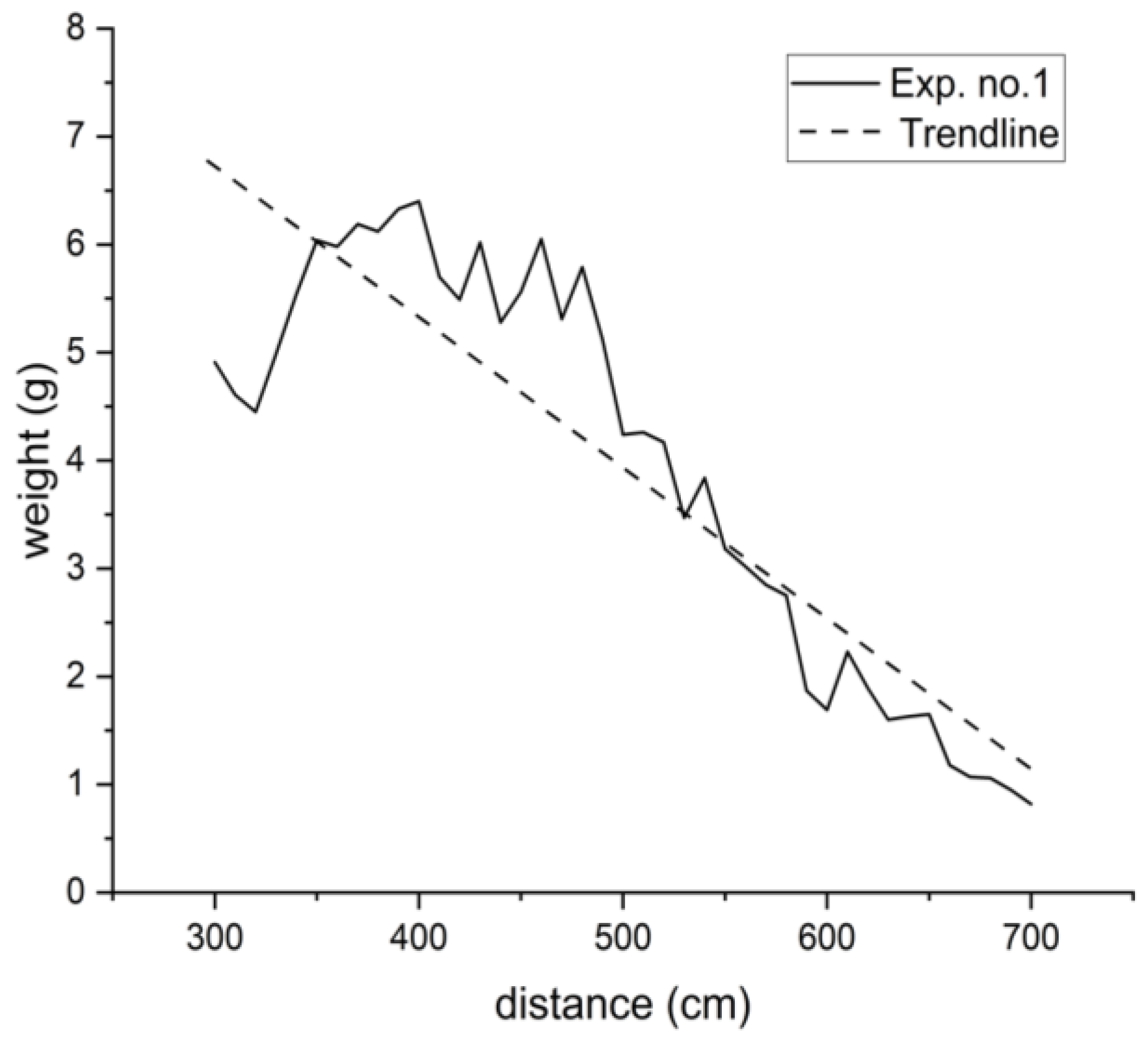
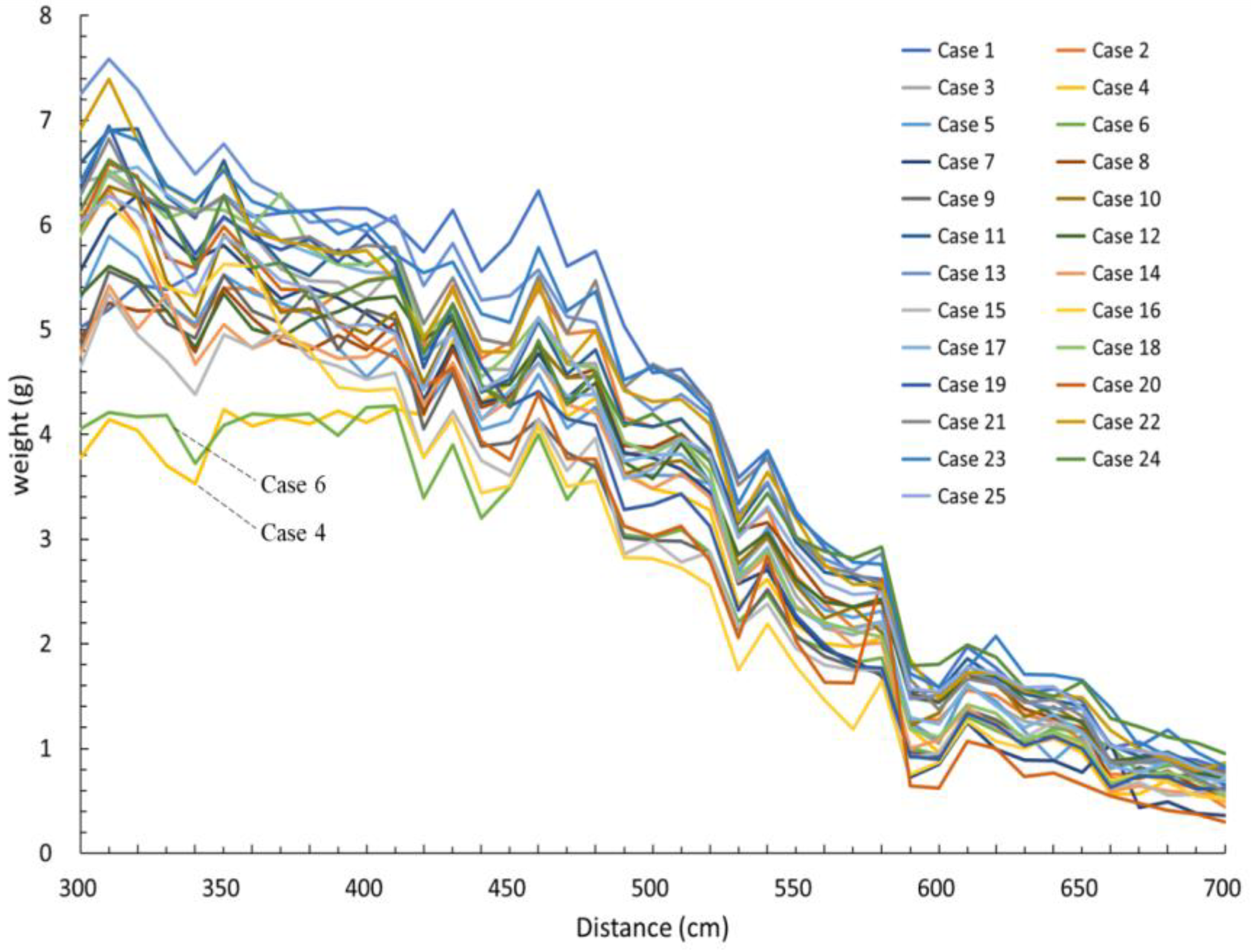


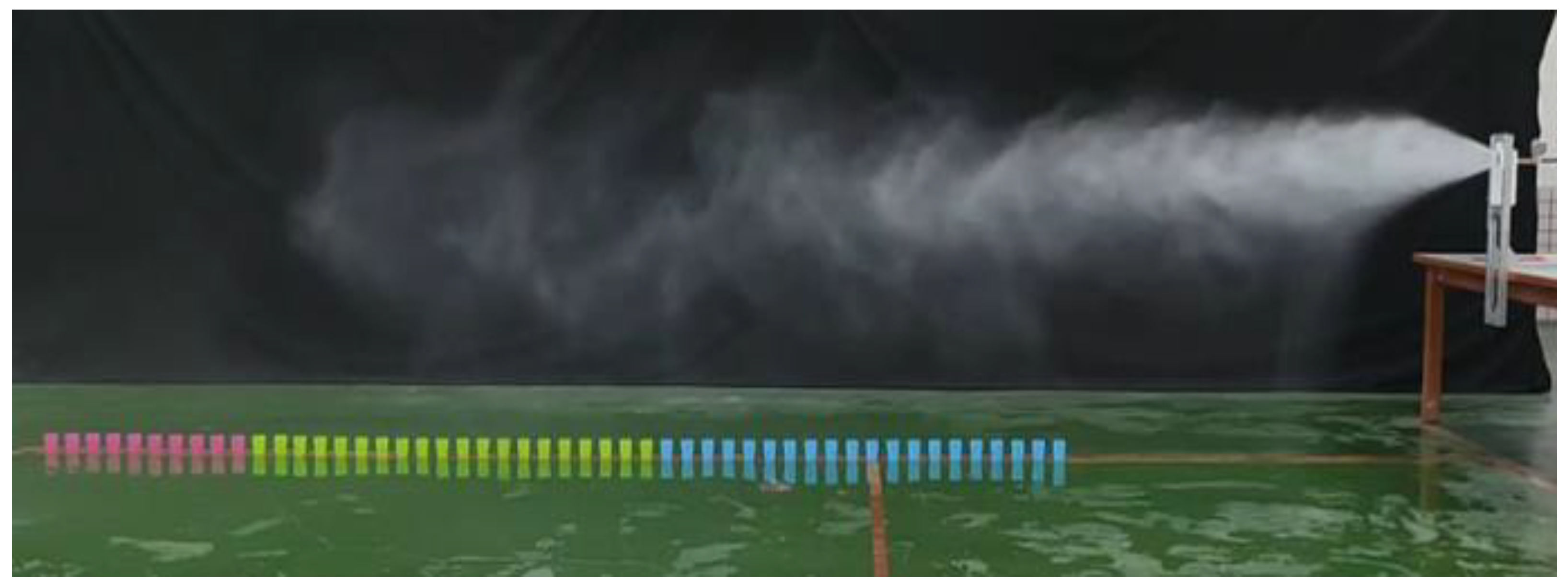

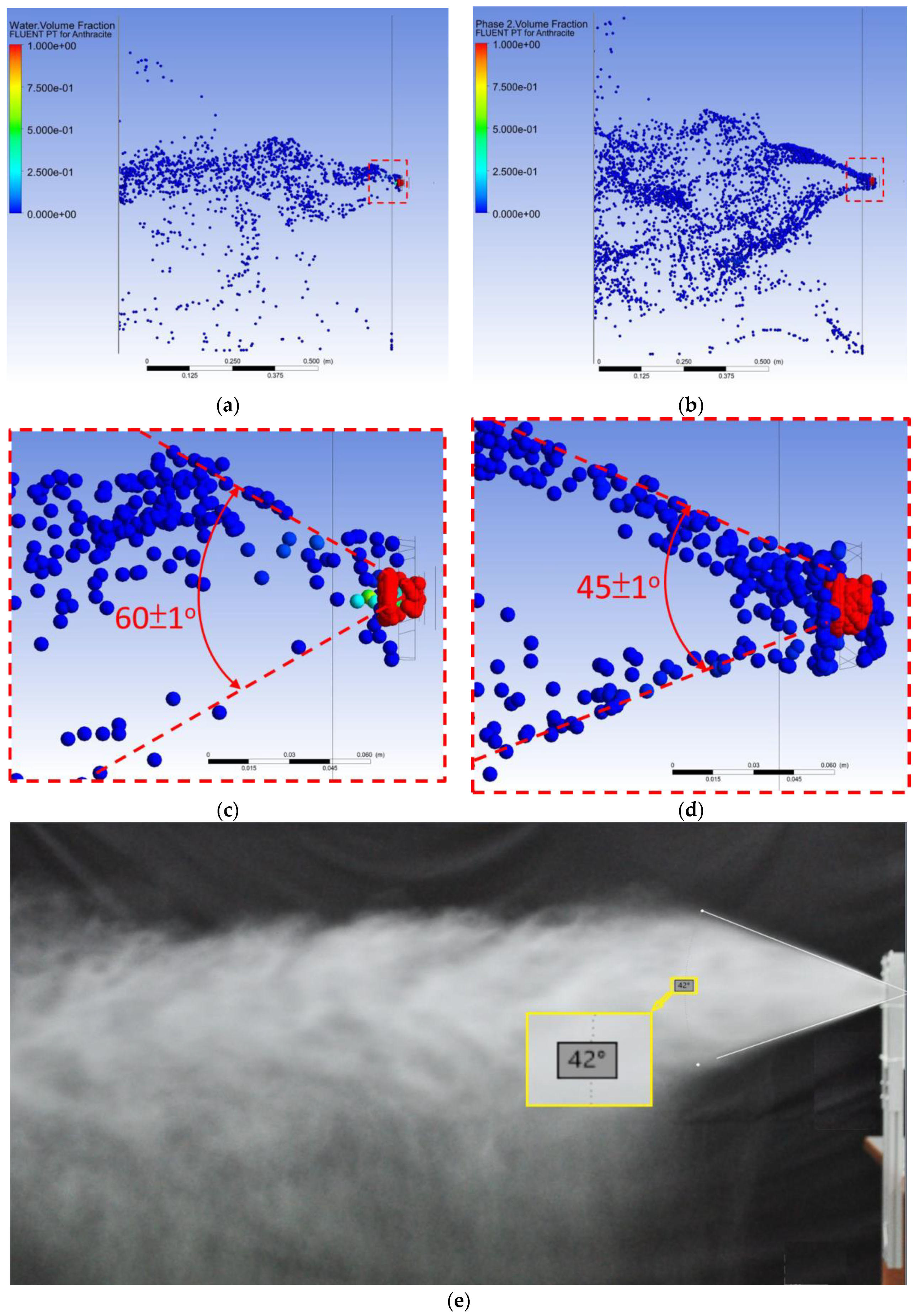
| Factor | Control Parameter | Level 1 | Level 2 | Level 3 | Level 4 | Level 5 |
|---|---|---|---|---|---|---|
| A | Number of holes | 5 | 6 | 7 | 8 | 9 |
| B | Inclination angle (°) | 5 | 10 | 15 | 20 | 25 |
| C | Flow area (mm2) | 9 | 12 | 15 | 18 | 21 |
| D | Length (mm) | 6 | 7 | 8 | 9 | 10 |
| Cases | A | B | C | D |
|---|---|---|---|---|
| 1 | 1 | 1 | 1 | 1 |
| 2 | 1 | 2 | 2 | 2 |
| 3 | 1 | 3 | 3 | 3 |
| 4 | 1 | 4 | 4 | 4 |
| 5 | 1 | 5 | 5 | 5 |
| 6 | 2 | 1 | 2 | 3 |
| 7 | 2 | 2 | 3 | 4 |
| 8 | 2 | 3 | 4 | 5 |
| 9 | 2 | 4 | 5 | 1 |
| 10 | 2 | 5 | 1 | 2 |
| 11 | 3 | 1 | 3 | 5 |
| 12 | 3 | 2 | 4 | 1 |
| 13 | 3 | 3 | 5 | 2 |
| 14 | 3 | 4 | 1 | 3 |
| 15 | 3 | 5 | 2 | 4 |
| 16 | 4 | 1 | 4 | 2 |
| 17 | 4 | 2 | 5 | 3 |
| 18 | 4 | 3 | 1 | 4 |
| 19 | 4 | 4 | 2 | 5 |
| 20 | 4 | 5 | 3 | 1 |
| 21 | 5 | 1 | 5 | 4 |
| 22 | 5 | 2 | 1 | 5 |
| 23 | 5 | 3 | 2 | 1 |
| 24 | 5 | 4 | 3 | 2 |
| 25 | 5 | 5 | 4 | 3 |
| Cases | Spray Distribution | Cases | Spray Distribution |
|---|---|---|---|
| 1 |  | 2 | 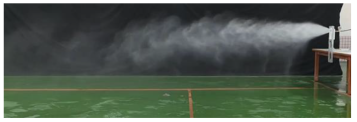 |
| 3 |  | 4 |  |
| 5 | 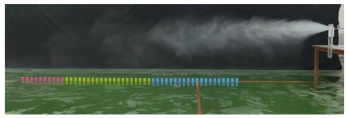 | 6 |  |
| 7 | 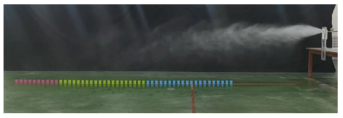 | 8 |  |
| 9 | 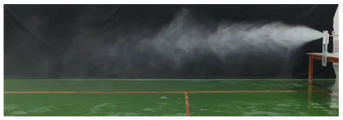 | 10 |  |
| 11 | 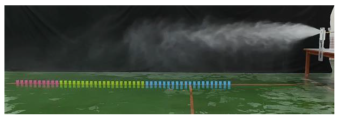 | 12 | 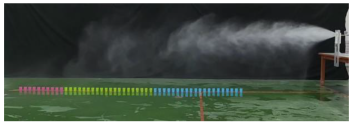 |
| 13 |  | 14 |  |
| 15 |  | 16 |  |
| 17 | 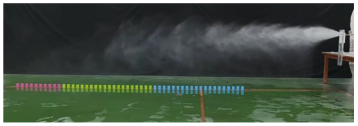 | 18 |  |
| 19 | 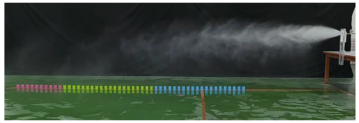 | 20 |  |
| 21 |  | 22 |  |
| 23 |  | 24 |  |
| 25 |  |
| Cases | A | B | C | D | y1 | y2 | y3 | S/N (dB) |
|---|---|---|---|---|---|---|---|---|
| 1 | 1 | 1 | 1 | 1 | 0.139 | 0.149 | 0.165 | 16.38 |
| 2 | 1 | 2 | 2 | 2 | 0.162 | 0.163 | 0.136 | 16.24 |
| 3 | 1 | 3 | 3 | 3 | 0.170 | 0.169 | 0.154 | 15.68 |
| 4 | 1 | 4 | 4 | 4 | 0.108 | 0.104 | 0.116 | 19.23 |
| 5 | 1 | 5 | 5 | 5 | 0.142 | 0.146 | 0.134 | 17.02 |
| 6 | 2 | 1 | 2 | 3 | 0.104 | 0.098 | 0.111 | 19.62 |
| 7 | 2 | 2 | 3 | 4 | 0.179 | 0.169 | 0.145 | 15.65 |
| 8 | 2 | 3 | 4 | 5 | 0.125 | 0.123 | 0.148 | 17.53 |
| 9 | 2 | 4 | 5 | 1 | 0.132 | 0.130 | 0.164 | 16.91 |
| 10 | 2 | 5 | 1 | 2 | 0.151 | 0.151 | 0.145 | 16.54 |
| 11 | 3 | 1 | 3 | 5 | 0.168 | 0.168 | 0.156 | 15.71 |
| 12 | 3 | 2 | 4 | 1 | 0.145 | 0.134 | 0.132 | 17.26 |
| 13 | 3 | 3 | 5 | 2 | 0.187 | 0.182 | 0.179 | 14.76 |
| 14 | 3 | 4 | 1 | 3 | 0.134 | 0.137 | 0.142 | 17.23 |
| 15 | 3 | 5 | 2 | 4 | 0.128 | 0.127 | 0.137 | 17.68 |
| 16 | 4 | 1 | 4 | 2 | 0.157 | 0.155 | 0.145 | 16.35 |
| 17 | 4 | 2 | 5 | 3 | 0.159 | 0.159 | 0.182 | 15.56 |
| 18 | 4 | 3 | 1 | 4 | 0.179 | 0.181 | 0.153 | 15.32 |
| 19 | 4 | 4 | 2 | 5 | 0.175 | 0.176 | 0.170 | 15.22 |
| 20 | 4 | 5 | 3 | 1 | 0.177 | 0.171 | 0.157 | 15.46 |
| 21 | 5 | 1 | 5 | 4 | 0.167 | 0.166 | 0.163 | 15.63 |
| 22 | 5 | 2 | 1 | 5 | 0.179 | 0.177 | 0.146 | 15.50 |
| 23 | 5 | 3 | 2 | 1 | 0.166 | 0.166 | 0.161 | 15.68 |
| 24 | 5 | 4 | 3 | 2 | 0.155 | 0.153 | 0.134 | 16.62 |
| 25 | 5 | 5 | 4 | 3 | 0.152 | 0.149 | 0.138 | 16.69 |
| Item | A | B | C | D |
|---|---|---|---|---|
| Level 1 | 16.911 | 16.738 | 16.195 | 16.340 |
| Level 2 | 17.251 | 16.043 | 16.888 | 16.103 |
| Level 3 | 16.527 | 15.794 | 15.823 | 16.955 |
| Level 4 | 15.583 | 17.042 | 17.412 | 16.704 |
| Level 5 | 16.023 | 16.677 | 15.977 | 16.194 |
| Range | 1.668 | 1.249 | 1.435 | 0.852 |
| Significance | 1 | 3 | 2 | 4 |
Disclaimer/Publisher’s Note: The statements, opinions and data contained in all publications are solely those of the individual author(s) and contributor(s) and not of MDPI and/or the editor(s). MDPI and/or the editor(s) disclaim responsibility for any injury to people or property resulting from any ideas, methods, instructions or products referred to in the content. |
© 2023 by the authors. Licensee MDPI, Basel, Switzerland. This article is an open access article distributed under the terms and conditions of the Creative Commons Attribution (CC BY) license (https://creativecommons.org/licenses/by/4.0/).
Share and Cite
Chen, J.-S.; Li, S.-R. Optimizing the Auxiliary Air Channels of a Vortex Atomizer by 3D Printing Using the Taguchi Method. Appl. Sci. 2023, 13, 5898. https://doi.org/10.3390/app13105898
Chen J-S, Li S-R. Optimizing the Auxiliary Air Channels of a Vortex Atomizer by 3D Printing Using the Taguchi Method. Applied Sciences. 2023; 13(10):5898. https://doi.org/10.3390/app13105898
Chicago/Turabian StyleChen, Jung-Shun, and Shang-Rong Li. 2023. "Optimizing the Auxiliary Air Channels of a Vortex Atomizer by 3D Printing Using the Taguchi Method" Applied Sciences 13, no. 10: 5898. https://doi.org/10.3390/app13105898
APA StyleChen, J.-S., & Li, S.-R. (2023). Optimizing the Auxiliary Air Channels of a Vortex Atomizer by 3D Printing Using the Taguchi Method. Applied Sciences, 13(10), 5898. https://doi.org/10.3390/app13105898




